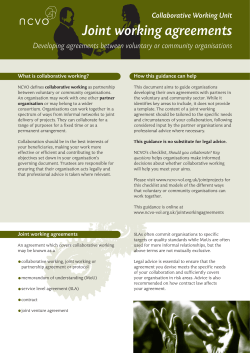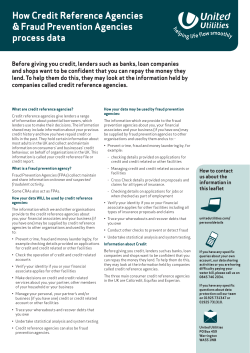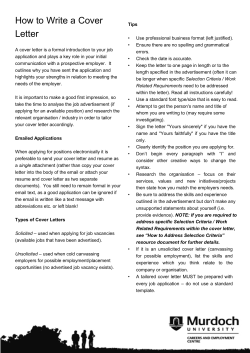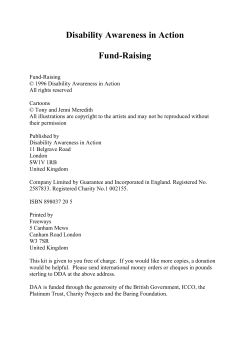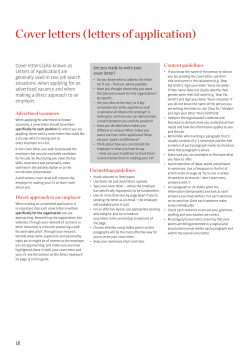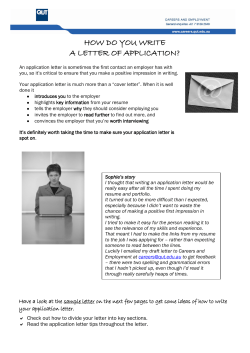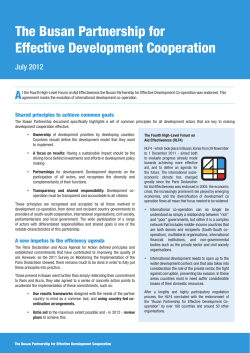
Joint Working for Public Service Delivery Collaboration Advice Notes:
Collaboration Advice Notes: Joint Working for Public Service Delivery 1 Introduction Joint working for public service delivery: a model of collaborative working Contents Page No Collaborative working is increasingly seen as good practice by the government and the voluntary and community sector1. This trend is driven both by increased pressure to achieve value for money and efficiency and by the belief that shared working can achieve more effective or joined up services. Collaborative working may take many forms, including mutual support of campaigns and events, jointly bidding for contracts or sharing of back office functions. An organisation may work with one or two others or may belong to a wider consortium. Collaborative working can last for a fixed time or be permanent. Introduction: Joint working for public service delivery 1 How do organisations work with public services? 2 Will a joint project meet your aims? 2 Why collaborate to deliver services? 3 Although much of the literature focuses on collaborations between voluntary and community organisations, they may also be developed with public or private sector organisations. 4 Please note: This guidance is no substitute for legal advice. 5 Purpose of this advice note 6 This is one of a series of advice notes covering different ways that voluntary and community organisations can work together. This advice note is focused on joint working for service delivery and is designed to assist organisations that are considering or that are in the process of developing/delivering joint working arrangements. It is aimed at chief executives, managers and trustees of organisations considering or undertaking public service delivery jointly with other voluntary and community organisations. Case study – Bytes Project and Tides Training Joint working agreements/contracts Case study – Altas Women’s Centre What to think about 6 Joint undertakings with other voluntary and community organisations 7 Who to work with? 7 Who should be the lead? 8 Managing relationships 8 Case study – Parenting NI and Family Mediation Northern Ireland 9 It is useful for voluntary and community organisations asking: • Why collaborate to deliver services? • How is joint service delivery different to delivering alone? • What do we need to think about when jointly contracting with public bodies? • What should agreements for joint projects include? A number of case studies will be presented which highlight examples of organisations that are working in partnership for the delivery of services. Accountability 10 Timescales 10 Full cost recovery 12 What do we mean by collaborative or joint working? Financial questions 12 Employment Issues 12 As shown in Figure 1, joint working involves two or more organisations coming together to deliver a joint project. This advice note outlines the logistics of making this happen. Communications 12 Promotion and branding of joint projects 13 Case study – Stepping Stones and Now Project 13 Case study – ASCERT and Opportunity Youth 13 Project cycle 14 A final thought….. 14 Figure 1: Joint working model Organisation Organisation Organisation A B C Joint Project 1 Collaborative working within the voluntary and community sector – also known as joint or partnership working – includes a spectrum of ways that two or more organisations can work together. Options range from informal networks and alliances, through joint delivery of projects to full merger. http://www.fundingcentral.org.uk/Page.aspx?SP=6296 2 3 This model explores how organisations can collaborate with their voluntary sector partners, as well as with public sector agencies, for public service delivery. The model concentrates on the relationship between voluntary organisations rather than partnership between voluntary organisations and public bodies. It examines: • Why organisations collaborate to deliver public services? • How is joint public service delivery different to delivering alone? • What do we need to think about when jointly contracting with public bodies? • What should agreements for joint projects include? Any collaborative arrangement should be documented as to how costs will be shared and who will be responsible for what. It is recommended that a collaboration agreement is put in place outlining all aspects of the joint project. Joint working for public service delivery Public services are those which public bodies (such as central or local government) either provide themselves or commission others to provide. The voluntary and community sector is well placed to bring distinctive or added value to the services it provides because of its2: • specialist knowledge or experience • involvement of users • independence of government • ability to reach hard to reach groups • innovative approaches to service delivery. How do organisations work with public services? Voluntary and community organisations may contract with public bodies to provide services or they may receive grants from them to contribute to their core costs or to fund particular projects. They may also work with them more informally, referring clients to public services, taking referrals from public bodies or sharing information. Public service delivery involves voluntary, community or private sector organisations delivering services that the state usually provides. Views differ on the point at which an organisation can be said to be taking on such a role, but public service delivery can take place in a wide range of fields such as social care, health, education, leisure and environmental management. Organisations can win contracts to provide a service on behalf of a primary care trust or another public body. The role of the voluntary sector in public service delivery can also complement its campaigning and advocacy role, and the sector can influence public services and offer advice on them, regardless of whether or not organisations are directly involved in service delivery. Will a joint project meet your aims? Voluntary and community organisations should only choose to deliver public services when it provides an opportunity for them to achieve their existing aims. Where voluntary organisations have a similar or complementary objectives, it may make sense for them to achieve their aims by working together rather than competing. There are many opportunities for organisations to get involved in collaborative working but a key question to ask is will such involvement help organisations meet their aims? This quote refers to a partnership between Action for Change and Addaction. The partnership evolved when the local Drug Advisory Team’s (DAT) commissioners made the decision to consolidate and re-tender, in an open competitive commissioning process, its existing contracts for substance misuse services to one single provider. Action for Change and Addaction formed a partnership and won the competitive tender. By collaborating, these organisations were able to achieve their complementary aims of supporting people with drug and alcohol “I’d be surprised if users knew this issues. was a partnership. The real question is, are they getting the The role of the voluntary and community sector in public services best service possible?” has generated much discussion, but the most important question John Reading, Chief Executive, remains whether involvement with the public sector helps Action for Change, on working organisations meet their objectives. The Charity Commission for with Addaction England and Wales has developed a checklist that is a simple guide to the typical issues trustees will need to think about when considering working collaboratively. Trustees must act in the interests of their charity which means that they should be satisfied that there will be adequate benefits to their beneficiaries3. Each organisation must stick to the objects in its own governing document and a joint project should reflect the objects of all the participants. A mission statement derived from an organisation’s objects has no legal standing. However, if joint service delivery means developing activities outside of its mission, this may indicate that they would be diverting resources away from core activities. This risk needs to be carefully managed. An organisation’s annual report could be used to explain how public service delivery furthers their aims. A voluntary or community organisation’s independence is vitally important, no matter how closely it works with another organisation or with public services. Trustees have ultimate responsibility for their organisation and must manage conflicts of interest. Examples of conflict of interests include direct financial gain or benefit to the trustee as a result of the joint project or the employment of a trustee in a new post which has emerged as part of the joint project. Organisations should ensure that they have structures in place to identify any conflict of interest and that they are fully advised as how these can be managed.4 Why collaborate to deliver services? Interest in and a greater push towards more collaborative working has been growing and the current policy direction is one which also encourages collaborative working. Commissioning bodies have responded by outlining the need to consider collaboration in bids and encouraging groups to work in collaboration. In Northern Ireland, commissioners including the Department for Social Development, the Department for Regional Development and the Arts Council, have made reference to consortium bidding in relation to contracting for services. By collaborating voluntary and community organisations can potentially offer savings and deliver the services that are needed by the communities with which they work. Community groups tend to know their local communities well and are perfectly placed to respond to local need and strengthen local communities5. 3 http://www.charity-commission.gov.uk/library/chkcolab.pdf http://www.charitycommission.gov.uk/Charity_requirements_guidance/Charity_governance/Good_governance/conflicts.aspx#12 5 http://www.fundingcentral.org.uk/Page.aspx?SP=6297 4 2 http://www.knowhownonprofit.org/funding/service/commissioning-and-procurement/copy_of_delivery 4 5 The advantages of working with other voluntary and community organisations can include: • for voluntary and community organisations, coming together can make the difference in a time of funding cuts; • reater overall capacity to improve outcomes for beneficiaries, which can lead to effective management, delivery and monitoring of the service; • lower overheads offers the opportunity for more money for frontline work; • increased capacity for organisations to replicate on a larger scale a successful service that a small organisation would be unable to scale up alone; • an increased knowledge pool to contribute to a more effective service; • the different specialisms of organisations may enable the service to be run smoothly across subsectoral boundaries eg. education and health; • organisations can share the risk involved in taking on public service delivery; • greater negotiating strength where organisations wish to respond to poor funding practice from a particular public body; • higher levels of trust where organisations have a common culture which is focused on need and quality of service, rather than being money-led. Case study: Bytes Project and Tides Training Joint working to support staff and beneficiaries: These two organisations combined their different expertise to develop a mediation training programme and train the trainer programme for the Bytes Project staff and beneficiaries. This programme assists young people to overcome extreme social and educational disadvantage and enables them to become economically active and make a positive contribution to their communities. The Bytes Project and Tides Training have worked together for over four years to deliver public services for complimentary objectives. The working relationship began when the chief executive of the Bytes Project contacted the chief executive of Tides Training as a result of identifying a staff training need. A member of staff at the Bytes Project had attended a training programme facilitated by Tides Training and brought back information on available training. The chief executive of the Bytes Project reviewed the training list and felt that some of it was relevant to their training needs but that the training needed to be more practical. She met with the chief executive of Tides Training to discuss the possibility of altering their mediation training programme so that it would give staff the skills to mediate conversations with young people. The two chief executives met several times to discuss the vision of the programme and to design the training package. Initially the chief executive of the Bytes Project envisaged a short training programme but what developed was a series of training building blocks for both staff and some service user representatives in developing mediation skills suitable for people with different abilities and a train the trainers programme. Both organisations ensured that their shared ethos was core when developing this training. Each organisation had expertise in different areas and worked together to include their expertise in the design of the training. To ensure that the training was appropriate Bytes staff undertook the training first and altered it to suit the needs of their services users. Once staff had undertaken the training they worked in pairs to develop new material which was then rolled out to beneficiaries. Through the process of designing and evaluating the training both organisations recognised that they had started a partnership and created a new relationship. One of the advantages of the partnership for Tides Training was that until that point it had never worked with young people so it was a learning experience for the staff. Youth provision has previously not been a priority for the organisation but through the partnership it became one of its strategic priorities. Another advantage for both organisations was that on occasion they have shared staff. In addition they have put in joint funding applications and have had some success with regard to mediation and conflict projects. Joint working agreements/contracts When organisations work together to deliver public services this work is usually underpinned by some form of written agreement. A written agreement can help maximise the likelihood of success through minimising risk, preventing misunderstandings and giving clarity and focus to collaborative work. It can also be invaluable in ensuring continuity if changes occur, for example if staff and trustees leave. These can include: protocols • memorandum of understanding (MoU) • heads of agreements or heads of terms • collaboration or joint working agreements • consortium agreement • joint venture agreement • service level agreement (SLA) SLAs often commit organisations to specific targets or quality standards while MoUs are often used for more informal relationships, but the above terms are not mutually exclusive. In addition to joint working agreements between collaborating voluntary and community organisations, agreements with public bodies vary in formality and legal standing. Voluntary organisations can work with the public sector through: • informal arrangements which may outline protocols only at operational level • grant agreements • memorandums of understanding • legally binding contracts, including service level agreements. These terms are not mutually exclusive. For instance, a memorandum of understanding about the service expected by the public body might be used alongside a grant agreement. This memorandum may be known as a service level agreement and may not be intended to be legally binding. Whether any agreement is legally binding depends on the intention of the parties involved. If a public body wants to procure a service, a contract is best practice. Organisations should seek their own legal and financial advice, rather than using the advisors used by the commissioning body, and should ensure they understand the extent of undertakings made in binding agreements. For example, it is important to identify any liability the agreement poses to your organisation or the personal liability of trustees. The need for insurance cover also needs to be considered. “If both parties to an arrangement intend the arrangement to be legally binding it is a contract, even if it is called something else.” Charities and Contracts, Charity Commission, September 2003 6 7 Case study: Atlas Women’s Centre Signing up to an agreement: Atlas Women’s Centre is involved in a Regional Women’s Centre Learning Partnership which has a commitment to reach ‘hard to reach’ women, offering both non-accredited and accredited training programmes. Within the project there are relevant supports such as childcare provision, one to one mentoring and outreach support, all of which are designed to make the idea of education and learning a more realistic option for women. At the start of the project each organisation signed up to a partnership agreement where they agreed to make a real and significant contribution by working collaboratively to realise the aims and objectives of the project. Within the agreement various contractual information was inserted, including: • The name of the project • Commencement and duration of the agreement (2009) • Aims of the partnership • Parties to the agreement • Roles and responsibilities of the lead partnership (WRDA) and the delivery partner organisations (14 organisations) • Project management committee • Governance/communication • Financial arrangement • Delivery of service • Administration, meetings and record keeping • Sustainability • Cessation of membership and new partners “The agreement is great, everyone is • Review and amendments of the agreement singing from the same hymn sheet.” • Disputes and arbitration Gay Sherry-Bingham, Manager, • Acceptance of agreement – signed and witnessed Atlas Womens Centre The organisation was very happy with the agreement and found the process to be straightforward. An external consultant was recruited and met with each of the 13 groups involved to decide the best format for the agreement. In terms of best practice when signing up to any collaboration agreement there are a number of things that organisations should consider. What to think about Voluntary and community organisations need to be sure they can fulfil the terms of any agreement before committing themselves to it. Agreements are often legally binding so an organisation may face legal action if its terms are not met. Before making the leap into collaboration, it’s important to consider potential problems. For example, do you risk mission drift because collaborating would mean moving away from your organisation’s core objects6? Will the structure of your organisation be affected by the change? If so, how will you deal with the long-term implications?7 6 A charity must follow its core objects. Where this fails to happen, it is often described as mission drift, and can result in charities engaging in activities that are outside their charitable aims, which is a breach of trust. http://www.charity commission.gov.uk/charity_requirements_guidance/specialist_guidance/education/higherres.aspx 7 Collaborating not merging - working together to cut costs and deliver services http://www.guardian.co.uk/voluntary-sector-network/2011/jan/25/collaborating-merging-working-together-costs Joint undertakings with other voluntary and community organisations While entering an agreement to provide services jointly with other voluntary and community organisations can spread the financial risk, it is important to be clear about: • who will participate • what the exact duties and contributions of each party will be • how management costs will be divided • what happens in the event of disputes between the collaborators (for instance, whether the dispute will go to professional arbitration or mediation and how the cost of this will be divided) • allocation of liability • to what extent any one party will be allowed to make commitments which bind all the collaborators • how the affairs of jointly-owned undertakings will be directed and managed. As with all new joint projects, your organisations should: • make sure the activity fits your aims by providing more or better services to beneficiaries • check it is compatible with your partner(s) • discuss how you are going to work together • agree respective roles and responsibilities • consider the effect of the collaboration on the activities of the whole organisation and other staff. Trustees, chief executives and managers should assess risk regularly and consider the following points before they go ahead with a joint delivery arrangement. Who to work with? It is important that organisations considering collaboration invest time in identifying who they would like to work in partnership with and not make rash decisions. Partnerships are often formed from existing networks or where there is a history of collaborative work between potential partners. However, there are circumstances where it is important “We drew up a ’would- like-to-meet’ to invite new partners to the table. These include when groups wish list for our ideal partners and then have identified gaps in expertise and skills in the participating set out to find organisations that met organisations. most of our criteria.” Stuart Rigg, Advance Chief Some organisations simply draw up a list of Executive on how Advance organisations that they consider to be viable potential identified Second Step, MIND in partners. Birmingham and Sussex Oakleaf as At the early stages of any collaborative process organisations strategic partners8 should examine • what they are hoping to achieve by collaborating with another organisation? • are they sure that collaborative working is the best way to achieve this aim? • does it fit within their organisation’s charitable objects as stated in their governing document? • do their plans for collaborative working fit their strategic vision, values and current priorities? It is also important to consider the other organisation’s charitable objects, philosophy, culture, governance, organisational structure, decision-making processes, policies, financial resources, assets and funding base and whether any areas of incompatibility can be overcome.9 8 http://www.ncvo-vol.org.uk/sites/default/files/ShouldYouCollab_Jan10.pdf 8 9 One of the key challenges for any collaborative process is personalities. Personality clashes and clashes of organisational culture are not uncommon so it is important that the individuals involved have open dialogue and maintain strong healthy relationships. Who should be the lead? To lead or not to lead, is one of the most important questions to be asked in many collaborative processes. Collaboration cannot work without strong leaders as they provide the motivation and leadership to help the collaboration be successful. However while it is important to have leadership from all organisations involved, it is important that one organisation takes a clear lead on the process. In some collaborative processes it will be clear from the beginning who should lead however in others the lead organisation will emerge as the process evolves. In some cases this can be a contested and challenging process. It may not be that the organisation that approaches others about the feasibly of joint working will be the natural leader. There are “Those who lead collaborative efforts many examples where organisations who initiate a collaborative ... rely on both a new vision of process are happy to be a party to it rather than a leader. leadership and new skills and Reasons for this include lack of capacity, resources or experience behaviours to help communities and in leading in a collaborative process. organisations realise their visions, solve problems and get results.“ Deciding who should be the lead organisation can be a difficult Scott London, and challenging process as organisations may not want to be Collaboration and Community10 seen as the lesser party to the collaboration. As lead organisation you need to be prepared and aware of what you and the other organisation(s) involved are willing to negotiate. You also need to be willing to take risks, listen to all parties and be able to share knowledge, power and credit. An effective lead organisations must guide and co-ordinate any decision-making process. Managing relationships Partnership working takes time. It is not a one off event, but rather it requires ongoing work. Negotiation and relationship management skills are essential when bidding for contracts and become more important as the number of organisations involved in a project increases. Where organisations are collaborating to work with public bodies, it is useful to assign someone to co-ordinate different strands of work. Usually there is a requirement from a funder for a lead partner; this is likely to be somebody from the organisation acting as the accountable body. When you think about collaboration it is important to remember that organisations themselves do not collaborate, it is the people who make up these organisations that collaborate. This can be challenging as quite often people fear change and a collaborative process is a change process. It requires people to share information outside of their organisation which they would not usually do. It goes against the natural grain of the organisation as it is sometimes in competition with the organisation it now is considering collaborating with. This means that people need to invest in relationships if they want to successfully collaborate. Some organisations feel that for a joint project to be successful, embedded relationships are essential. 9 10 http://www.ncvo-vol.org.uk/advice-support/collaborative-working/information-and-tools/shouldyoucollaborate Scott London, Collaboration and Community, http://www.scottlondon.com/reports/ppcc.html Case study: Parenting NI and Family Mediation Northern Ireland (FMNI) Building relationships: This case study outlines the process undertaken by two organisations that were working collaboratively on an informal basis towards a more strategic collaborative commitment to best support their beneficiaries. Reasons for working together Both organisations work with parents and families going through times of difficulty. They share the same ethos and value base and have always signposted each other’s services on an informal basis. The chief executives in both organisations have known each other for a number of years, and Pip Jaffa, Chief Executive of Parenting NI, is also chair of FMNI’s board and has an excellent understanding of FMNI and the work that it does. The relationship between the two organisations is very positive. Through the delivery of their services, staff in both organisations recognise that their beneficiaries come to them in times of need and are often unsure of which organisation they should go to for support. In many cases these individuals contact or are directed to the wrong organisation and can find it difficult to access the most appropriate service. “We have the same ethos and value base but are we really making the best of the services we are delivering to parents? How could we make it easier for them to access the services?” Joan Davis, Director, FMNI. While staff from both organisations sign posted each other when they realised that the other organisation could provide additional or more appropriate support, there was no way to measure if clients then contacted the other organisation once advised of their services. Both organisations came to the view that if they worked together they could better support people to access the right services and put in place a more formal structure with regard to the way people are referred to these services. What went well One of the most positive things about this partnership is that the organisations already had a great working relationship with both chief executives working with each other on other “I have been in post for three years partnerships such as the Child Maintenance and Enforcement and have a great relationship with Division (CMED). This relationship was Pip who was first a member of the further cemented by the realisation that by board of FMNI and is now chair. working in partnership the organisations would be Our partnership wasn’t a light bulb able to help clients reach the services moment, more an organic natural they need quicker. progression and bonding of the organisations via the personalities Both feel their partnership is one of equals and no one organisation involved.” has control over the project. In addition, even though both Joan Davis, Director, FMNI. organisations were disheartened not to have been successful in securing funding for the joint project, they have continued to establish it and will run a pilot in August 2012 to measure its success. “If two people in the organisations know each other then you could start with them first because they could build on their relationship.” Joan Davis, Director, FMNI Advice Joan Davis, Director of FMNI, advises that if a relationship has already been established between potential partnering organisations, this should be built on at the start of any collaborativeprocess to build communication and trust. 10 11 Accountability “Voluntary and community organisations undertake to have clear lines of accountability, especially with joint bids.” Funding and Procurement: Compact Code of Good Practice It is good practice for collaborating organisations to have a joint agreement setting out their respective areas of responsibility and financial arrangements. These may include distribution of funding and how management accounts will be used to give each party the information it needs for its own reporting. Each organisation would then account for their part in the project in their own accounts. When they sign an agreement, all partners, including the commissioning body, need to be clear about their specific liability, including liability for the defaults of other partners. For example, if Organisation A cannot deliver their part of the service agreed, but partner Organisation B does, can Organisation B still receive full payment? Using public money means you will be accountable to the commissioning body and there maybe regulatory requirements to be met. One organisation will be responsible for reporting to funders and will have to have the systems and personnel in place to collate this information. You will also remain accountable to your beneficiaries, partner organisations, members and others. Collaborating may put a greater burden on your monitoring and reporting systems. Therefore it is very important to agree such systems for the monitoring and returning of information. Timescales When tendering for a contract, organisations are subject to the timescale set by the commissioning body. Organisations working as a consortium may need longer to prepare bids, negotiate contracts and monitor results. Therefore they need to be sure that these activities can be completed within the agreed timeframe. More frequently however commissioners encourage a partnership approach in the delivery of services. Interested organisations form collaborative relationships to position themselves to tender for new contracts. Collaborations evolve from many different beginnings. Sometimes having a cup of coffee at a conference and finding you have something in common with another organisation, can be the beginning of a strategic alliance. Often in the sector, organisations have built on informal alliances and increasingly some are taking forward these relationships in terms of corsortia bids. Some may argue it is better the devil you know, and the key thing is ‘knowing’ the person with whom you are considering a collaboration. By having this information, and deciding if you can work with them, you may be in a position to act quickly if an appropriate consortia opportunity presents itself. Case Study: ASCERT and Opportunity Youth Building on an established relationship: This case study outlines the process undertaken by two organisations that have formed a collaborative partnership for the provision of alcohol and drug services for young people and their families. ASCERT and Opportunity Youth work in partnership on three services including: * Daisy (East and West) are services for young people who are at risk of, or already are misusing drugs and alcohol or who are indirectly affected by another person’s substance misuse. These projects provide young people and their families with an individual tailored package of support. * Targeted Education Service delivers bespoke courses and accredited programmes to young people at risk of substance misuse and their parents, providing qualifications in drug and alcohol awareness, sexual health, peer education and peer mentoring. Reasons for working collaboratively There were two main drivers behind this collaboration. Firstly, the chief executives of both organisations were involved in the Independent Sector Forum and had been chosen to represent the voluntary and community sector on the development group for the new strategic direction on alcohol and drugs. Through these platforms the chief executives got to know each other well and to understand the work undertaken by both organisations. It became “We were in meetings a lot clear that both had a similar vision with regard to supporting young together and got to understand people. each other’s people, which is While it is often helpful to structure time for collaboration, sometimes the best collaborative experiences occur spontaneously and are opportunistic, as in this case. very important in any collaborative working. We got to know each other’s organisations and skills.” Anne-Marie McClure, Chief Executive, Opportunity Youth. The secondary driver was the Eastern Drug and Alcohol Co-ordination Team (EDACT) which, in an open competitive commissioning process in 2006, called for tenders for a young people’s early-intervention programme. Both ASCERT and Opportunity Youth were very interested in delivering the service but felt that it needed a partnership approach. “This funding opportunity arose and we wanted to Through working at a strategic level in the link in with an organisation that had a wider Independent Sector Forum and representing the geographic experience.” voluntary and community sector on the new strategic Gary McMichael, Director, ASCERT. direction on alcohol and drugs the organisations “Regardless of what it may say in a textbook about got a sense of the potential direction of partnership working, in reality it is sometimes future services. It became apparent opportunistic. An opportunity presented itself that when drugs and alcohol which we thought of a solution to. It would be to services were re-tendered in partner with another provider whose experience 2008 there was likely to be a different approach would increase the likelihood of success and we by the commissioners. EDACT wanted to combine went into partnership with Opportunity Youth to the early-intervention work, which ASCERT and compete for the tender on that basis.” Opportunity Youth had the contract for, with the Gary McMichael, Director, ASCERT. young people’s treatment service, which Opportunity Youth had the contract for. Opportunity Youth and ASCERT had conversations about how they could work together on this as EDACT wanted to see a partnership approach to the “We were very aware that the funder tender. was looking for a tender that brought a range of skills together in one programme rather than in separate programmes. So the funder was very clearly looking for a joint partnership approach.” Anne-Marie McClure, Chief Executive, Opportunity Youth. 12 13 Full cost recovery Full cost recovery refers to recovering or funding the full costs of a project or service. As well as the costs directly associated with the project (staff and equipment) projects will also draw on the resources of the rest of the organisation including adequate finance, human resources, management, and IT systems which are integral components of any project or service. The full cost of any project therefore includes an element of each type of overhead cost, which should be allocated on a comprehensive, robust, and defensible basis. Collaborating takes time and resources. Organisations should understand the full costs of delivering a service, including the cost of collaborating in order to set a price for the service. Consider the time spent on management, liaison, and meetings, monitoring and the cost of travel11. Financial questions There are a number of financial questions that must be considered and constantly monitored when working jointly to deliver services. First and foremost organisations should know the full cost of delivering joint services; this will take account of both financial and human resources. It is important to know if there will be a cost saving for your organisation or if the collaboration could affect your organisation’s potential income. Other factors to consider include: • Are there VAT implications in charging for a service? • Will payment for the service be in advance or arrears? • How can you prepare for a loss of income once the project ends? • Are your plans for sharing information about individuals compliant with data protection legislation? • Who will hold copyright for any guidance material that results? – think about intellectual property, design and trademark. Promotion and branding of joint projects Joint branding and promotion of joint ventures is good practice. There may also be a requirement from the funder in relation to promotion of the project and acknowledging their support. Case study: Stepping Stones and Now Project Stepping Stones NI and the NOW Project are organisations that have made a strategic decision to invest in their collaborative arrangements. The two organisations have a long and successful working relationship. They are jointly delivering supported employment projects and are now on their second wave of successful collaboration with a new project called Project Workforce. The project is funded by The European Social Fund, Department of Employment and Learning and the Health and Social Care Trusts for Belfast and the South Eastern area. Project Workforce offers transition, training and employment services to beneficiaries, offering a personcentred approach to help clients achieve their goals. It caters for a spectrum of beneficiaries and provides support in moving on from school, sourcing suitable training courses and in gaining voluntary, part-time or full-time paid work. Employment Issues Branding If new work, undertaken though the collaboration, involves staff moving from one employer to another, organisations may be affected by TUPE, the Transfer of Undertakings (Protection of Employment) Regulations. Legal advice should be taken on how this applies to you. As part of their collaborative journey, Stepping Stones and NOW have published joint promotional material outlining the work of both organisations. For the Project Workforce service the contact details and logos of both organisations feature on its information leaflet. Other employment issues which could potentially arise if the joint service is staffed with employees from different organisations could include a variance in terms and conditions, such as differences in salaries for the same role, difference in working hours, pensions, payment of overtime or allocation of time off in lieu. In addition, splitting project manager and employer roles between two or more partnering organisations may blur responsibilities for both HR issues and employer duties and responsibilities. For example who will be responsible for supervising staff the organisations employing that staff? Will it be the legal employer of the employee or will it be the organisation with responsibility for leading the joint services?12 Communications Trustees should make sure that they safeguard their organisation’s reputation and that its brand is not damaged. • Do you need to outline to stakeholders how working on public services contributes to your objectives? For instance, receiving funding from a public body may represent a significant change to your funding mix – explain to current funders any implications for existing services and how jointly delivering public services will benefit the client group. • How might partnership with this voluntary sector partner and with a public body affect organisational reputation? • Have you included communication protocols in your joint working agreement? ACEVO have published guidance on calculating costs & full cost recovery. Full cost recovery: A guide and toolkit on cost allocation is for small organisations whilst Funding our future II: understand and allocate costs is for larger organisation 12 http://www.idea.gov.uk/idk/aio/6416033 11 Case Study: ASCERT and Opportunity Youth In this collaboration, one of the things that worked well is that each of the three joint services (Daisy East, Daisy West and the Target Education Service), has its own branding. They are not identified as an Opportunity Youth or ASCERT service but are branded in such a way that the services stand out on their own. . While staff come from the two organisations they promote the service as a single identity. On any promotional leaflet the projects have their own logo and information with only a small reference to ASCERT and Opportunity Youth. “The staff have always been nurtured into their team.” John Hunsdale, Assistant Director, ASCERT “The services have their own identity and the teams have grown together.” Anne-Marie McClure, Chief Executive, Opportunity Youth 14 15 Project cycle for the joint working arrangements • Have you agreed management and review mechanisms? • Have you put in place contingency plans? Regular risk analysis is important. • What are the criteria and arrangements for ending the project? Contracts should include a termination clause. • What arrangements do you need to make for the end of the project? A final thought….. “There are barriers and enablers to successful joint working. Long-term cultural change is necessary to support this new approach. Joint working is dependent on achieving a significant cultural change and building on existing best practice. However, it can appear an enormous task and perhaps even slightly overwhelming for those closely involved.” Peter O’Hara, Joint working, Drives for Changes13 Further advice and information Collaboration NI http://www.collaborationni.org/ 028 9087 7777 13 http://www.publicnet.co.uk/features/2009/02/27/joint-working-the-drive-for-change/ Notes 16 17 Notes Notes To find out more about CollaborationNI contact Leeann Kelly Programme Co-ordinator, CollaborationNI, NICVA 61 Duncairn Gardens, Belfast BT15 2GB Email leeann.kelly@nicva.org Tel 028 9087 7777 Web www.collaborationni.org Follow us on twitter@Collab_NI
© Copyright 2025
